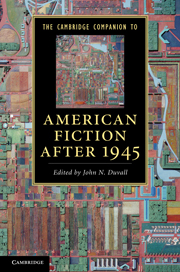Book contents
- Frontmatter
- Introduction: A story of the stories of American fiction after 1945
- PART I POETICS AND GENRES
- PART II HISTORICAL AND CULTURAL CONTEXTS
- 6 African American fiction
- 7 American Indian fiction
- 8 Multiethnicities: Latino/a and Asian American fiction
- 9 American Jewish Fiction
- 10 Feminist fiction
- 11 Southern fiction
- 12 Fiction and the Cold War
- 13 Fiction and 9/11
- PART III MAJOR AUTHORS
- Conclusion: Whither American fiction?
- Index
- Cambridge Companions to …
6 - African American fiction
from PART II - HISTORICAL AND CULTURAL CONTEXTS
Published online by Cambridge University Press: 28 March 2012
- Frontmatter
- Introduction: A story of the stories of American fiction after 1945
- PART I POETICS AND GENRES
- PART II HISTORICAL AND CULTURAL CONTEXTS
- 6 African American fiction
- 7 American Indian fiction
- 8 Multiethnicities: Latino/a and Asian American fiction
- 9 American Jewish Fiction
- 10 Feminist fiction
- 11 Southern fiction
- 12 Fiction and the Cold War
- 13 Fiction and 9/11
- PART III MAJOR AUTHORS
- Conclusion: Whither American fiction?
- Index
- Cambridge Companions to …
Summary
African American fiction of the last seventy years has largely been defined by dichotomies: ideological/aesthetic, male/female, traditional/experimental. While there is some relevance to these categories, the deeper reality is that there has been a remarkable range of themes, styles, and techniques displayed in this body of work. Despite pressures at various times to make black writing fit a rigid definition or to expel authors from the race for their work, authors have consistently produced narratives that defy easy categorization. Much of the debate about black narrative has been carried out in essays and articles that extend back to the early twentieth century, when W. E. B. Du Bois contended that black writing should serve as propaganda for the advancement of the race and attacked Claude McKay, among others, for his failure to do so. Langston Hughes responded with his declaration of artistic freedom that rejected either black or white proscriptions on the black writer. We see variations on this conversation in the critiques of Richard Wright by Ralph Ellison and James Baldwin; in the Irving Howe/Ellison debate; in the denunciations of Ellison by participants in the Black Arts Movement; in Clarence Major's responses to his work; in Ishmael Reed's assaults on white critics, feminism, and black women writers; and finally in the manifesto by Trey Ellis on a New Black Aesthetic. All the while, writers were going about the business of producing an array of fictions that always exceeded the arguments about what they were doing.
- Type
- Chapter
- Information
- The Cambridge Companion to American Fiction after 1945 , pp. 83 - 98Publisher: Cambridge University PressPrint publication year: 2011

